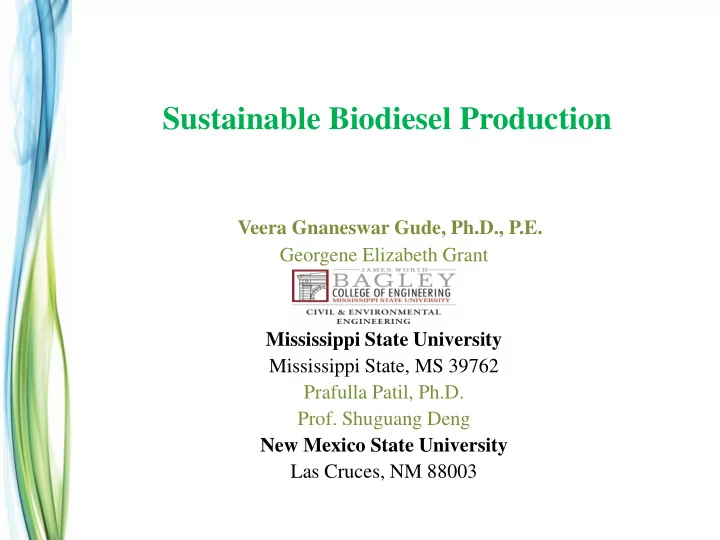

Sustainable Biodiesel Production Veera Gnaneswar Gude, Ph.D., P.E. Georgene Elizabeth Grant Mississippi State University Mississippi State, MS 39762 Prafulla Patil, Ph.D. Prof. Shuguang Deng New Mexico State University Las Cruces, NM 88003
Biodiesel Production • The world biodiesel production has increased by more than 10 times (between 2001 and 2010) while the U.S. biodiesel production has increased exponentially (by 200% every year).
Oil Prices for Biodiesel Production • Biodiesel production increase can be directly related to the escalating gasoline and diesel prices over the past decade which are expected to rise in the future. • Projections for increase in oil prices (feedstock) with increased biodiesel production
Biodiesel Production • Current biodiesel technologies are not sustainable. This is mainly due to: 1) high feedstock cost (up to 75-80% of the total biodiesel cost) 2) energy intensive process steps involved in their production – Food vs. Fuel issues – Energy vs. Environment issues
Sustainable Biodiesel Production For biodiesel to substitute conventional gasoline as an alternative transportation fuel should: (i) have superior environmental benefits (ii) be economically competitive ( iii ) have meaningful supplies to meet energy demands, and ( iv ) have a positive net energy balance ratio (NER)
Sustainable Biodiesel Production Low Cost, Waste and Renewable Feedstock • Low Environmental Impact • Low Cost Biodiesel Non-Conventional • Improved Quality Heating and Mixing • High Net Energy Technologies Benefit • Sustainable Production Potential Renewable Energy Utilization
Biodiesel Feedstock and Methods
Oils to Biodiesel Transesterification
Biodiesel from Low Cost Feedstock • Waste cooking oils • Low cost and maintenance crops Jatropha Curcas Camelina Sativa
Biodiesel from Low Cost Feedstock 100 100 (A) (C) Biodiesel Yield (%) Biodiesel Yield (%) 80 80 60 60 40 40 WCO WCO 20 20 Jatropha Jatropha Camelina Camelina 0 0 0 3 6 9 12 15 20 60 100 140 Reaction Temperature (˚C) MeOH:Oil molar ratio (B) 100 100 (D) Biodiesel Yield (%) Biodiesel Yield (%) 80 80 60 60 40 40 WCO WCO 20 20 Jatropha Jatropha Camelina Camelina 0 0 0 0.5 1 1.5 2 2.5 0 50 100 150 200 Catalyst Concn (%) Reaction Time (min)
Process optimization
Non-Conventional Heating
Ultrasonic Conversion 65 60 55 50 Temperature (˚C) 45 40 35 30 0.5 min 1.0 min 1.5 min 2.0 min 25 2.5 min 20 0 15 30 45 60 75 90 105 120 135 150 Reaction Time (min)
Novel Heating Methods • Low energy requirements • Short reaction times • Short separation times • High product quality • Easy operation
Algae: Microwave Process Crude Biodiese l
Algae: Process Optimization • Optimal conditions: – Dry algae to methanol ratio of 1:12 (wt./vol.), – KOH concentration of 2% (wt.%) and – Reaction time of 4 – 5 min at a reaction temperature around 60 – 64 C – The maximum FAME yield of 80.13% (based on total lipid content) Microwave irradiation is more effective in the destruction of the cells and accelerates better the transesterification reaction in a shorter reaction time.
Algae: Renewable Feedstock • Energy various steps of biodiesel production: 1) Cultivation; 2) Feedstock processing; 3) oil extraction; 4) oil conversion into biodiesel; and 5) separation and purification.
Net Energy Benefit Ratio (NER)
NER for Different Feedstock
Conclusions • Biodiesel can be produced with minimum environmental pollution by using renewable feedstock. • Net energy benefit of the biodiesel production process can be increased by using high oil yielding and low energy consuming feedstock (low maintenance, low cost). • Biodiesel production costs can be reduced by utilizing locally available waste cooking oils and by utilizing process by- products as raw materials in other chemical processes. • Utilizing renewable feedstock such as algae will reduce the environmental emissions and facilitate nutrient recovery and wastewater reuse and recycling. • Non-conventional technologies such as microwaves and ultrasonics have potential to reduce the energy footprint of the biodiesel processes.
Recommend
More recommend